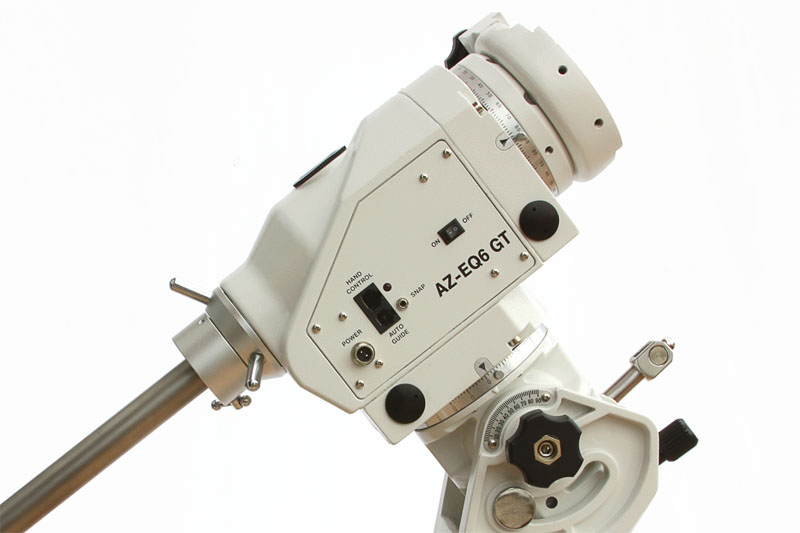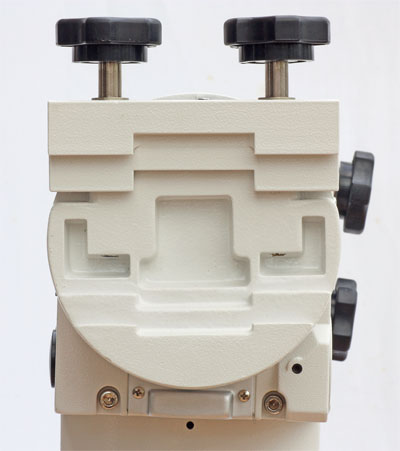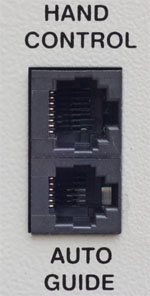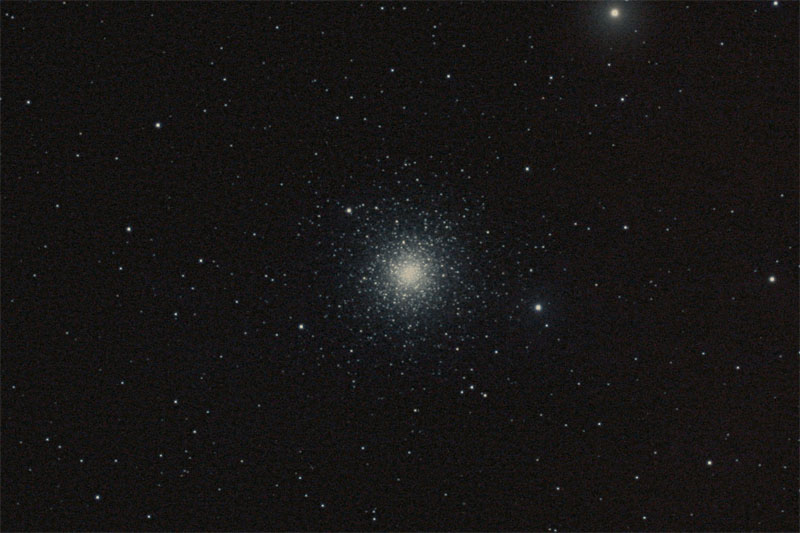Skywatcher AZ EQ6-GT Review Part-21 Comment29 July 2013 | Steve The new Skywatcher AZ EQ6-GT has had a successful launch and has been well received. Customer feedback so far is excellent and we have experienced zero returns but there is still very little in the way of in-depth reviews on the internet. To remedy this we sent one to Steve Richards for a long-term review. Steve Richards is the author of ‘Making Every Photon Count’ and writes for The Sunday Times, BBC Sky at Night Magazine and BBC Focus Magazine. Here is part-2 of his Skywatcher AZ EQ6-GT review. The first part of the review can be read here: Skywatcher AZ EQ6-GT Review Part-1
IntroductionIn part 1 of this long-term review I looked at the constructional features of the new mount with some general comparisons against the original NEQ6. The mount has a lot going for it especially as it has appeal to both astro-photographers and observers alike because of its dual identity – not many mounts are capable of making the transformation from an equatorial mount to an altazimuth mount as elegantly as the AZ-EQ6 GT. Astro-photographers, however, require various attributes from their mounts to ensure the best quality images and the first of these is that it should be an equatorial mount. An equatorial mount follows the apparent movement of the stars across the sky in a smooth continuous arc whereas an altazimuth mount moves in a series of discrete horizontal and vertical steps. Although an altazimuth mount will keep an object centred in the field of view, over a long period of time, the field of view will appear to rotate resulting in what is known as ‘field rotation’. Field rotation produces elongated stars around the periphery of the frame which spoils the image but also indicates clearly that the main object must also have rotated and thus been blurred and distorted in the process. What makes for a good Equatorial Mount for observing? The following attributes should be high on your wish-list:-
The AZ-EQ6GT in useDespite appearing larger than the NEQ6, the AZ-EQ6GT is actually lighter and very easy to set up on the substantial tripod, being retained by a single long M12 bolt that is also threaded at its base to hold the cast aluminium leg spreader/eyepiece holder in place. I moved the azimuth post 180° from its original position between two legs to immediately above a single leg to give a more comfortable kneeling position with more space when adjusting the polar alignment – this also gave me a ‘north pointing leg’ which is a handy precursor to future polar alignments.
The DEC head has a dual Losmandy/Vixen saddle clamp that is the same design as that of the NEQ6 and is much nicer than the usual locking bolt that can mar the finish of the dovetail bar. This saddle works well with both dovetail types and has two clamping bolts to clamp the saddle firmly on the bar. However, it does share a minor issue with the NEQ6 in that there are no guide rods in the design so the moving part of the saddle tips slightly when you tighten it. I resolved this by simply inserting a piece of card under the moving section to stabilise it, this solution worked perfectly. There are various methods of polar aligning the mount, including aligning the polarscope engravings of Ursa Major (The Big ‘Dipper’) and Cassiopeia with these constellations in the night sky, matching the imaginary ‘clock face’ of the Polaris engraving with the Polaris position given by the SynScan handset or by using an automated routine using two alignment stars from the handset. The automated routine has already gone through some changes and, depending on which firmware version you are using, might even be absent. The current version 3.35 firmware seems stable and the polar alignment routine worked well. My own preferred method however was to use a phone app that produces a graphic showing the position of Polaris and then transposing this onto the view through the polarscope. Having placed Polaris in the correct rotation in the polarscope, it is then a simple matter of adjusting the altitude and azimuth bolts on the mount until Polaris is centred in the little Polaris circle engraved in the polarscope’s reticule. The single altitude bolt on this design really did make this aspect of the alignment much easier than on the NEQ6 and many other similar mounts. With the mount polar aligned, the next stage is to carry out a star alignment to map the handset’s sky model to that of the real sky. For observing sessions, where a range of different objects were going to be viewed over a large part of the sky, I normally used a two star alignment although a three star option is also available. For imaging, where I would be staying put on a single object for the whole session, a one star alignment was more than sufficient. The start point for any star alignment process with this mount is with the counterbalance bar pointing downwards and the telescope pointing upwards. If this is carefully carried out, the first alignment star normally appears comfortably within the telescope’s finderscope and more often than not, within the telescope’s eyepiece when using a short focal length instrument. After carrying out a 2 star alignment, using the bright stars Arcturus and Vega as my alignment stars, I chose the tiny planetary nebula, M57, The Ring Nebula as my first target, followed by globular clusters M13 and M92 and all three objects were presented perfectly centred using my 5mm eyepiece and 600mm focal length refractor. Moving on to the much larger open cluster M44, the Beehive Cluster, I found it perfectly centred in my 17mm eyepiece even though it was located on the other side of the meridian. Galaxies M51, M81 and M82 soon followed and every object I chose was easily located within my telescope’s eyepiece so I was rather impressed with the accuracy of the GoTo system. I was pleased to note that the noise from the mount when slewing was very low and movements were very smooth. For each GoTo command the mount performed a major slew followed by some fine adjustments before beeping to confirm that it had finished. During my observational testing, objects remained near the centre of my 17mm eyepiece for well in excess of an hour. A rather nice feature, if you want to move very quickly to a new target, is that you can unlock the clutches and manually, move the telescope to point to a new location and the mount encoders will keep track of where you have moved to. When you re-engage the clutches, the operating system will continue as normal.
The AZ-EQ6GT is ASCOM compliant but more than this, it is fully supported by EQMOD*. This is a real bonus because, good though the SynScan handset may be, EQMOD makes operation of the mount quicker and more intuitive with full control being handed over to your planetarium software or other ASCOM compatible software. The AZ-EQ6GT in use for astro-photographyMoving on to astro-photography, I measured the periodic error at 25.4 arcseconds peak to peak with an RMS value of 7.7 arcseconds which is an improvement on a typical NEQ6 mount and this was delivered smoothly so was easy to autoguide out using typical 2 second guiding intervals. The mount has a built in industry standard ST4 guide port but if you use EQMOD, you can guide the mount using pulse guiding as an alternative. Should you wish, this latter option will open up the possibility of running Periodic Error Correction (PEC) and autoguiding at the same time, although I tend to rely purely on autoguiding for correcting tracking errors. To give an idea of what the mount is capable of unguided, I took a sequence of 120 second exposures of the globular cluster, M3 using a Canon EOS 450D DSLR camera and my 600mm focal length refractor. I was very pleasantly surprised by the quality of the star shapes that I captured with no PEC or guiding in operation.
Cropped 120 second exposure of globular cluster M3
ConclusionThe build quality that I discovered in part 1 of this review gave the promise of good things to come from the field-testing and the SkyWatcher AZ-EQ6GT did not disappoint. Quick and easy one person assembly despite a good payload capacity, simple polar alignment, easy star alignment, accurate GoTos and straightforward guiding make this a compelling purchase for those interested in a good equatorial mount for astro-photography. Observers too will appreciate the GoTo accuracy which covers the whole sky even from a simple two star alignment. * Information on EQMOD can be found on First Light Optics’ website here. Steve Richards is the author of ‘Making Every Photon Count’ and writes for The Sunday Times, BBC Sky at Night Magazine and BBC Focus Magazine. |
|









Many thanks for your helpful reviews of this attractive mount.
Could I confirm that the 600mm fl refractor that you used for the M3 example unguided shot, was the 80mm ED APO, please?
Thanks again. I now know my budget target!